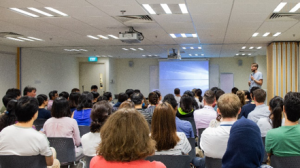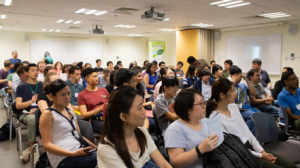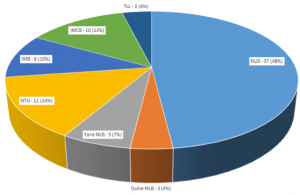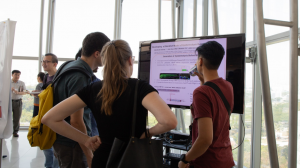Singapore Fish Meeting 2018
Posted by dbsste, on 11 October 2018
On 2nd October 2018, the Mechanobiology Institute in Singapore hosted a meeting of Singapore-based researchers using fish in their work. We wanted to bring together the local community to build support and promote future research collaborations within Singapore. This meeting follows successful international conferences last year in Singapore, where the importance of fish in both fundamental and translational research was apparent (https://thenode.biologists.com/developmental-biologists-meet-lion-city/events/, https://www.zdmsociety.org/past-events).
The fish community in Singapore, despite running up against the usual funding challenges and regulations, remains a formidable group. Over 80 people attended during the afternoon, with the room literally full to bursting, Figure 1. Researchers came from National University of Singapore, Nanyang Technological University (both universities recently built state-of-the-art fish facilities), A*Star and Duke-NUS (Figure 2).


Figure 1. Top: Timothy Saunders addressing an overwhelming crowd of scientists in the Singapore Fish Meeting 2018. Bottom: Anticipation of the first talk.
The half-day meeting saw presentations by twelve young scientists (students, post-docs and research associates). There was also a poster session going on late into the evening, including one on a wide-screen LED TV (Figure 3). Notably, women presenters made up more than half (9/12 talks and 6/11 posters) of the presenters, deriving from a roughly equal proportion of male and female participants. The talks comprised a wide-ranging topics from fundamental biology, through to medical applications and engineering. A clear strength was in the use of fish in disease modelling, but there were also interesting presentations related to ageing, behaviour, and fluid mechanics. It was a powerful demonstration of the versatility of fish models for studying a broad range of topics. It was particularly stimulating to get fresh research ideas and tools, and also to immerse ourselves in the work of our colleagues covering unfamiliar territory.

Figure 2. Affiliation breakdown of participants in the Singapore Fish Meeting 2018. NUS – National University of Singapore (including the Cancer Science Institute and Mechanobiology Institute); IMB – Institute of Medical Biology; IMCB – Institute of Molecular and Cell Biology; NTU – Nanyang Technological University; TLL – Temasek Life Sciences Laboratory.
The day finished with pizza and wine, which provided a platform for cross-fertilization of expertise to spawn new ideas and projects. The fish meeting was a wonderful success – great talks, lively discussions, and good food. It was also an important opportunity to bring together the local fish community. We believe that the fish community in Singapore will continue to do great science and be a driving force of scientific discoveries through inter-disciplinary cooperation.

Figure 3. Abraha (hidden) presenting his Next-Gen poster to a group of curious scientists.
The community would also like to take this opportunity to remember the late Professor Hong Yunhan from National University of Singapore, who pioneered the generation of haploid medaka stem cells.
About the Authors:
Dr. Jason Lai has just graduated from the Stainier Lab in Bad Nauheim, Germany to pursue his post-doctoral training with Timothy Saunders. He is interested in growth and form, particularly related to the Hippo/YAP pathway (https://www.researchgate.net/profile/Jason_Lai6)
Asst. Prof. Timothy Saunders is a principal investigator at the Mechanobiology Institute, Singapore (https://mbi.nus.edu.sg/timothy-saunders/saunders-lab/). He brings his background in physics to tackle problems in developmental biology, such as how complex organ form emerges. He has recently published his first work in Zebrafish, collaborating with Prof. Philip Ingham (https://www.cell.com/developmental-cell/fulltext/S1534-5807(18)30697-X).


 (6 votes)
(6 votes)